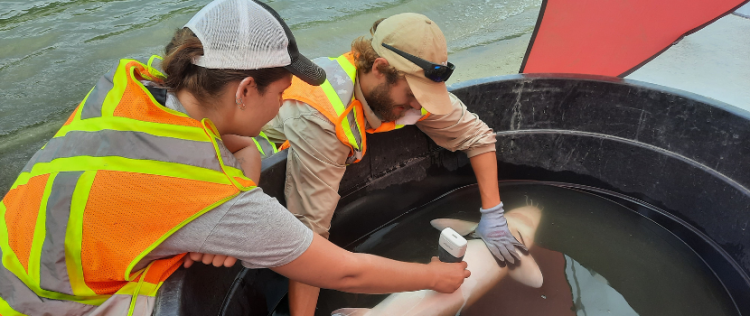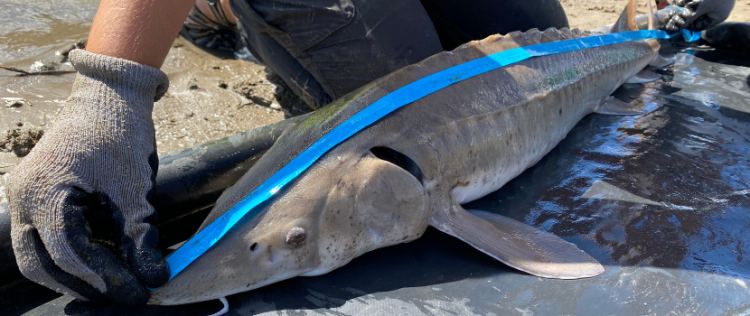
Image Credit: Saskatchewan Polytechnic
In the cool, murky waters of the North Saskatchewan River, the Lake Sturgeon silently swims, its lineage stretching back 200 million years. The pre-historic fish is currently on the endangered list and Saskatchewan Polytechnic researchers and students have been hard at work to collect information on the reproductive health and population dynamics of this remarkable species without causing further harm.
"Lake Sturgeon possess several unique features that distinguish them from other freshwater fish in North America," says David Halstead, professional biologist and research chair of the School of Agriculture, Natural Resources and Sustainability. "They have a cartilaginous skeleton and are covered in bony plates called scutes that give them protection and a prehistoric appearance. They also can live up to 100 years and are slow to mature, with females typically not spawning until they are 20-25 years old."
This three-year applied research project was funded by a $230,000 grant from the Natural Sciences and Engineering Research Council of Canada (NSERC) and industry partner, Cenovus Energy. Sask Polytech students and researchers used innovative methods to gather critical data on Lake Sturgeon spawning cycles. At the heart of the research was the use of portable ultrasound technology and passive integrated transponder (PIT) tagging. These techniques allowed researchers to assess the reproductive status of Lake Sturgeon and track them over time without resorting to invasive procedures.
Cole Tomlinson, an Integrated Resource Management and Geographic Information Science alumni, worked on the project as a student during his studies and for two years as the lead research technologist. "I've always had a love for the river," says Tomlinson. "Lake Sturgeon are my favourite fish; they are so unique. When Dave approached me to work on this project it was a dream come true. To work on the river and learn more about this ancient fish has been the highlight of my career."

Image Credit: Saskatchewan Polytechnic
Field methods focused on proper fish handling techniques to minimize stress and injury to these important fish. With barbless hooks and careful handling protocols, the applied research team ensured that Lake Sturgeon were caught safely and returned to the river after being scanned and tagged. Tomlinson adds, "We always put the health of the fish first. We made sure not to pull them through the mud and sand. Not to lift them by the gill covers, mouth, eyes or tail. We always held them horizontally and weighed them in a cradle or sling."
"The team's research focused on a key question, how many Lake Sturgeon in the North Saskatchewan River are capable of spawning in a given year?" says Halstead. It's not possible to distinguish between male and female Lake Sturgeon by sight, so the researchers turned to ultrasound technology to capture images of the Lake Sturgeon's internal anatomy as a means of determining sex and assessing reproductive maturity and condition.
"Unlike most North American fish species, Lake Sturgeon do not spawn annually. Females only spawn every four to seven years and males every two to three years. This irregular spawning cycle makes it incredibly challenging to manage and protect the species effectively."
Over the course of the project, 852 Lake Sturgeon were captured. Of these captures, 674 were marked with PIT tags and an additional 55 were recaptured from Sask Polytech's own previously sampled population or other agency studies. Only 136 of the captures measured over 1.2 meters in length, indicating a strong likelihood of having achieved sexual maturity. Among these 136 captures, 63 were confirmed female and 31 male using ultrasound procedures. When these ratios are extrapolated over the entire population, taking into consideration reproductive periodicity, only about 3-4 per cent of mature females are likely to spawn each year.
"The findings were both illuminating and concerning," says Halstead. "This is a huge, ground-breaking study. We have this prehistoric, endangered species and we don't know much about them. We have learned there is very little spawning potential with this fish and the likelihood of egg survival is low. We must do more to protect and help this population succeed and grow. A big part of this protection is likely to involve the provision of sufficient quality habitat."
The project not only provided critical insights into the Lake Sturgeon's limited reproductive capacity but also laid the groundwork for ongoing monitoring. With 700 fish now tagged, future studies will be able to track changes in the population and assess the effectiveness of conservation measures. Potential next steps include mapping Lake Sturgeon movements using GIS to help plan future conservation efforts.
"During the study we found one individual sturgeon that was previously tagged in Alberta," Halstead shares. "It traveled an exceptionally long distance in the North Saskatchewan River from the Edmonton region to Prince Albert. It's remarkable to have historic information to see how far the fish can travel and how much they have grown. When complemented with ultrasound images, its like receiving a medical diagnosis for each individual fish at different stages of development."
As the research continues to yield insights, the team is committed to raising public awareness about Lake Sturgeon. "Outreach is crucial, as public support and understanding are key to the long-term survival of Lake Sturgeon," says Halstead.
Halstead would like to remind the public that regulations stipulate a zero-harvesting limit for Lake Sturgeon. "We wish to discourage anglers from targeting this endangered species for the sake of a photograph," he shares. "However, we recognize incidental captures do occur when fishing other species. If you happen to come across a Lake Sturgeon, please implement safe handling procedures and release them carefully."
Sask Polytech engages in applied research, drawing on faculty expertise to support innovation by employers and providing students the opportunity to develop critical thinking skills. The institution's Sustainability-Led Integrated Centre of Excellence (SLICE) is an industry-centric, solution-oriented development and deployment centre that's bringing sustainable development to Saskatchewan and Canada through local technology solutions with global application potential.
Learn more about applied research opportunities with Sask Polytech at saskpolytech.ca/slice and saskpolytech.ca/research.













